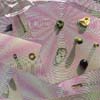 What can you say about 76 year old composer Francis Dhomont? You couldsay he's been given lots of prizes for his noises. You could say hetalks a good acousmatic game theory. You could say he wears an eyepatchover his right eye. He first grabbed my attention with his"Frankenstein Symphony" on Asphodel, a plunderphonic acousmatic journeyon which he skillfully cut up and stitched together various excerptsfrom works by his French Canadian contemporaries. He now tips his hatto perhaps his biggest inspiration. This sound cycle is a fiftiethanniversary homage to musique concrète pioneer Pierre Schaefer,specifically the first movement of his "Étude Aux Objets," from whichDhomont has sourced his raw materials. There are many furtivesimilarities to the Schaefer original, but Dhomont stretches thejourney out almost twice as long and eschews Schaefer's violent tapesplice edits, focusing and magnifying curiously questioning speakerpanning whirls into successive new smoothed out seascapes. In theopening funeral march, "Objets Retrouvés," the sounds seem to be askingthemselves what they are, curious to find themselves hanging aroundtheir own echoes. Dhomont breathes new life into them and gives themcelebratory purpose. The second cycle "AvartArsSon" paints in the skyfrom a more varied and clattering palette. Sounds loom into theforeground, shimmer and mutate. Latterly choral vox limbo over gluggingmystery spools. Bells ring out across the city full of gleeful honkingtaxis, soon washed away by tidal waves. This is the most cinematic ofthe four cycles, in that more untransmuted sound sources are apparentthan in relatively abstracted sequences elsewhere. The third cycle"Novars" was the first to be completed and is the hub around which theothers rotate, but since it is sequenced after "Objets Retrouvés"despite being completed seven years earlier, it seems like an extendedversion thereof. "Phonurgie" hones and magnifies elements from theprevious cycles casting long late summer evening shadows and deep poolreflections, folding mystery into myth. Latterly it seems as if severalglass instrument orchestras are playing cut up fragments in reverse asthey sink into the sea. A little recurring chuckle is a mirthfulreminder of how much fun listening can be.
What can you say about 76 year old composer Francis Dhomont? You couldsay he's been given lots of prizes for his noises. You could say hetalks a good acousmatic game theory. You could say he wears an eyepatchover his right eye. He first grabbed my attention with his"Frankenstein Symphony" on Asphodel, a plunderphonic acousmatic journeyon which he skillfully cut up and stitched together various excerptsfrom works by his French Canadian contemporaries. He now tips his hatto perhaps his biggest inspiration. This sound cycle is a fiftiethanniversary homage to musique concrète pioneer Pierre Schaefer,specifically the first movement of his "Étude Aux Objets," from whichDhomont has sourced his raw materials. There are many furtivesimilarities to the Schaefer original, but Dhomont stretches thejourney out almost twice as long and eschews Schaefer's violent tapesplice edits, focusing and magnifying curiously questioning speakerpanning whirls into successive new smoothed out seascapes. In theopening funeral march, "Objets Retrouvés," the sounds seem to be askingthemselves what they are, curious to find themselves hanging aroundtheir own echoes. Dhomont breathes new life into them and gives themcelebratory purpose. The second cycle "AvartArsSon" paints in the skyfrom a more varied and clattering palette. Sounds loom into theforeground, shimmer and mutate. Latterly choral vox limbo over gluggingmystery spools. Bells ring out across the city full of gleeful honkingtaxis, soon washed away by tidal waves. This is the most cinematic ofthe four cycles, in that more untransmuted sound sources are apparentthan in relatively abstracted sequences elsewhere. The third cycle"Novars" was the first to be completed and is the hub around which theothers rotate, but since it is sequenced after "Objets Retrouvés"despite being completed seven years earlier, it seems like an extendedversion thereof. "Phonurgie" hones and magnifies elements from theprevious cycles casting long late summer evening shadows and deep poolreflections, folding mystery into myth. Latterly it seems as if severalglass instrument orchestras are playing cut up fragments in reverse asthey sink into the sea. A little recurring chuckle is a mirthfulreminder of how much fun listening can be.
samples:
Read More

